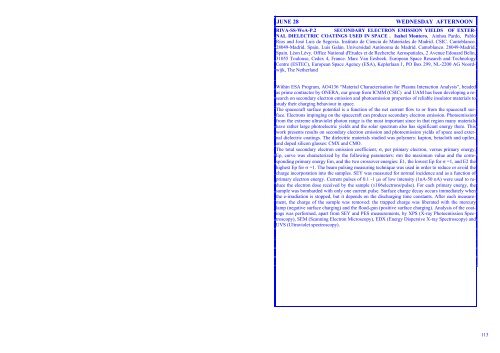Wüest M. 51 Wykes M. 82 Yamaguchi M. 17 Ybarra G. 129 Yubero F ...
Wüest M. 51 Wykes M. 82 Yamaguchi M. 17 Ybarra G. 129 Yubero F ...
Wüest M. 51 Wykes M. 82 Yamaguchi M. 17 Ybarra G. 129 Yubero F ...
Create successful ePaper yourself
Turn your PDF publications into a flip-book with our unique Google optimized e-Paper software.
JUNE 28 WEDNESDAY AFTERNOON<br />
RIVA-SS-WeA-P.2 SECONDARY ELECTRON EMISSION YIELDS OF EXTER-<br />
NAL DIELECTRIC COATINGS USED IN SPACE . Isabel Montero, Ainhoa Pardo, Pablo<br />
Rios and José Luis de Segovia. Instituto de Ciencia de Materiales de Madrid. CSIC. Cantoblanco.<br />
28049-Madrid. Spain. Luis Galán. Universidad Autónoma de Madrid. Cantoblanco. 28049-Madrid.<br />
Spain. Léon Lévy. Office National d'Etudes et de Recherche Aerospatiales, 2 Avenue Edouard Belin,<br />
31055 Toulouse, Cedex 4, France. Marc Van Eesbeek. European Space Research and Technology<br />
Centre (ESTEC), European Space Agency (ESA), Keplerlaan 1, PO Box 299, NL-2200 AG Noordwijk,<br />
The Netherland<br />
Within ESA Program, AO4136 “Material Characterisation for Plasma Interaction Analysis”, headed<br />
as prime contractor by ONERA, our group from ICMM (CSIC) and UAM has been developing a research<br />
on secondary electron emission and photoemission properties of reliable insulator materials to<br />
study their charging behaviour in space.<br />
The spacecraft surface potential is a function of the net current flow to or from the spacecraft surface.<br />
Electrons impinging on the spacecraft can produce secondary electron emission. Photoemission<br />
from the extreme ultraviolet photon range is the most important since in that region many materials<br />
have rather large photoelectric yields and the solar spectrum also has significant energy there. This<br />
work presents results on secondary electron emission and photoemission yields of space used external<br />
dielectric coatings. The dielectric materials studied was polymers: kapton, betacloth and upilex,<br />
and doped silicon glasses: CMX and CMO.<br />
The total secondary electron emission coefficient, σ, per primary electron, versus primary energy,<br />
Ep, curve was characterized by the following parameters: σm the maximum value and the corresponding<br />
primary energy Em, and the two crossover energies: E1, the lowest Ep for σ =1, and E2 the<br />
highest Ep for σ =1. The beam pulsing measuring technique was used in order to reduce or avoid the<br />
charge incorporation into the samples. SEY was measured for normal incidence and as a function of<br />
primary electron energy. Current pulses of 0.1 -1 μs of low intensity (1nA-50 nA) were used to reduce<br />
the electron dose received by the sample (≤106electrons/pulse). For each primary energy, the<br />
sample was bombarded with only one current pulse. Surface charge decay occurs immediately when<br />
the e-irradiation is stopped, but it depends on the discharging time constants. After each measurement,<br />
the charge of the sample was removed: the trapped charge was liberated with the mercury<br />
lamp (negative surface charging) and the flood-gun (positive surface charging). Analysis of the coatings<br />
was performed, apart from SEY and PES measurements, by XPS (X-ray Photoemission Spectroscopy),<br />
SEM (Scanning Electron Microscopy), EDX (Energy Dispersive X-ray Spectroscopy) and<br />
UVS (Ultraviolet spectroscopy).<br />
113
















